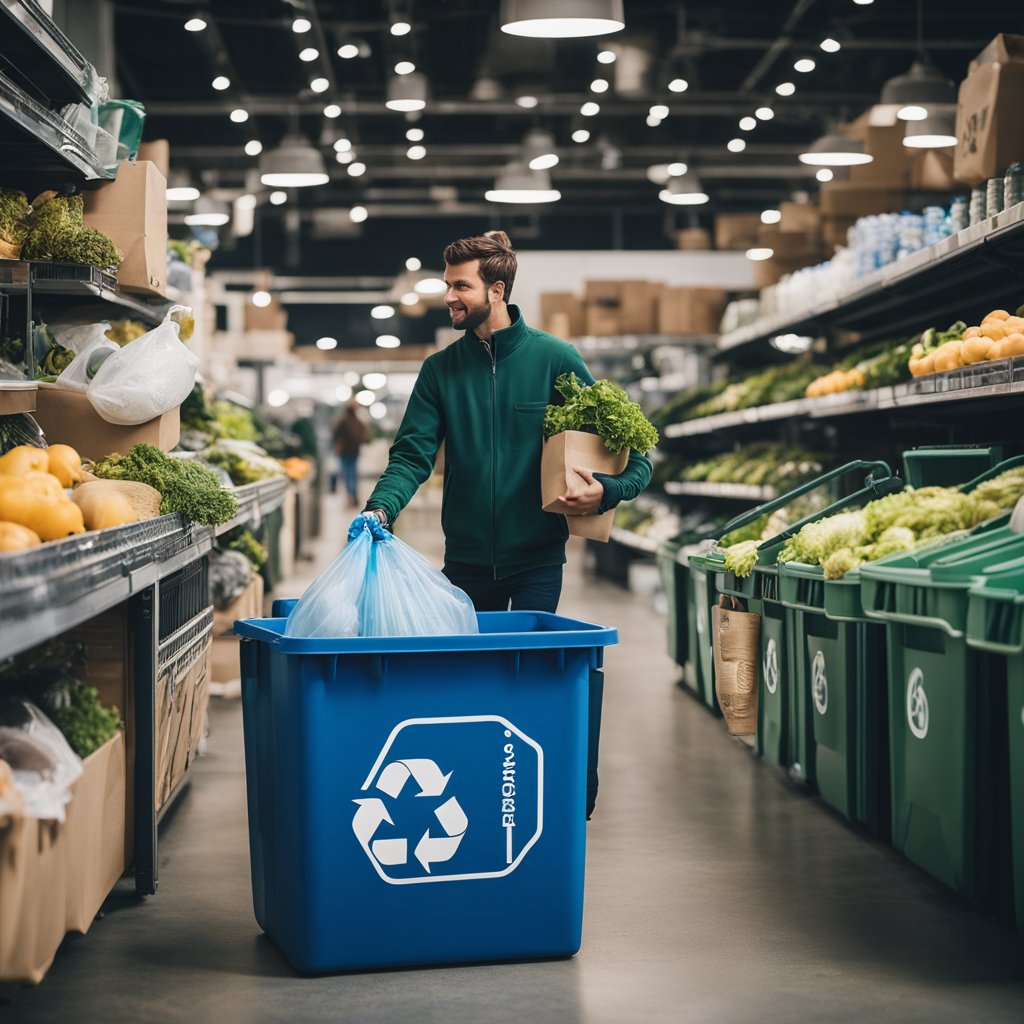How to Reduce Your Plastic Waste with Everyday Changes for a Greener Future
By Alex Reynolds |

How to Reduce Your Plastic Waste with Everyday Changes for a Greener Future
Reducing plastic waste is an important goal for many people who care about the environment. Simple changes in daily habits can lead to a significant decline in the amount of plastic used. Making small adjustments like using reusable bags, choosing products with less packaging, and avoiding single-use plastics can greatly lessen one’s environmental impact.
Many individuals may feel overwhelmed by the idea of cutting down plastic use, believing that it requires significant effort or lifestyle changes. In reality, it’s about being mindful and making choices that are easy to stick with. They can take a few simple steps to make a difference every day.
Awareness plays a vital role in this journey. By learning about the harmful effects of plastic and understanding the benefits of alternatives, they can motivate themselves to change. This article will explore practical tips that anyone can incorporate into their life to help reduce plastic waste.
Understanding Plastic Pollution
Plastic pollution is a pressing issue that affects the environment and human health. It results from the excessive use and improper disposal of plastic products. This section explores the impact of plastic waste on a global scale and elaborates on different types of plastics and their common uses.
The Global Impact of Plastic Waste
Plastic waste has significant effects on ecosystems worldwide. Each year, millions of tons of plastic enter oceans, rivers, and landscapes. This debris harms wildlife, as animals often ingest plastic or become entangled in it.
The presence of microplastics is also concerning. These tiny plastic particles can enter the food chain, affecting marine life and, ultimately, human health.
Countries are increasingly recognizing the need for regulations and initiatives to combat plastic pollution. Public awareness campaigns aim to educate about the consequences of plastic waste, encouraging individuals to adopt sustainable practices.
Types of Plastics and Their Uses
There are several common types of plastics, each serving different purposes:
- PET (Polyethylene Terephthalate): Often used in bottles and containers, it is recyclable.
- HDPE (High-Density Polyethylene): Found in milk jugs and detergent bottles, it is sturdy and can also be recycled.
- PVC (Polyvinyl Chloride): Used for pipes and construction, it poses environmental hazards if not disposed of properly.
- LDPE (Low-Density Polyethylene): Commonly seen in grocery bags and wraps, it is less commonly recycled.
Understanding these types helps consumers make informed choices. Choosing products made with recyclable plastics or reducing the use of single-use plastics can significantly cut down plastic waste.
Evaluating Personal Plastic Use
Understanding personal plastic consumption is essential for making meaningful changes. By examining everyday habits, individuals can identify where they can reduce plastic use effectively.
Conducting a Plastic Waste Audit
To start, she should collect all plastic waste generated over a week. This includes items like food packaging, bottles, and bags. After gathering this waste, it can be helpful to sort it into categories, such as:
- Single-use plastics: straws, cutlery, and shopping bags
- Packaging: food wrappers, product packaging, and containers
- Beverage containers: plastic bottles and cups
Next, she can count the items in each category. This will provide a clearer picture of which types of plastic are most prevalent in her life. It is beneficial to note any patterns, such as buying takeout often or purchasing bottled beverages. This audit serves as a foundation for understanding where changes can be made.
Identifying Key Areas for Reduction
After completing the audit, it is important to pinpoint specific areas for reduction. She can ask questions like:
- Which items can be replaced with reusable alternatives?
- Are there brands that use less packaging?
- Can she buy in bulk to minimize plastic waste?
For example, using a reusable water bottle and shopping bags can significantly cut down on single-use plastics. Transitioning to bulk purchases can also reduce packaging waste. Furthermore, opting for products with minimal or no plastic packaging is another effective approach.
By focusing on these key areas, she can create a targeted plan to reduce her plastic footprint and contribute positively to environmental efforts.
Reducing Plastic in Daily Life
Everyday actions can significantly lower plastic waste. Simple changes during shopping and using alternatives to single-use plastics can help make a difference.
Shopping with Minimal Plastic
When shopping, choosing items with less plastic packaging is crucial.
- Bring reusable bags: Store multiple reusable bags in the car or by the door. This makes it easier to remember to use them.
- Avoid packaged items: Select fresh produce instead of pre-packaged fruits and vegetables. Unwrapped items are often cheaper and better for the environment.
- Shop local: Farmers’ markets often have less plastic packaging. Buying directly from local farmers can also lead to fresher options.
Taking these steps can help reduce plastic waste right from the start of the shopping trip.
Alternatives to Single-Use Plastic Items
Finding alternatives to single-use plastics is essential for reducing waste.
- Use reusable water bottles: Instead of buying bottled water, use a refillable bottle. It saves money and cuts down on plastic usage.
- Switch to cloth napkins: Instead of paper napkins, use cloth. This small change can make a big impact over time.
- Choose glass or stainless steel containers: These options are better for storing food and drinks. They last longer and don’t produce waste like plastic containers do.
Making these simple switches contributes to a healthier planet and helps reduce plastic footprint.
Kitchen and Food Storage
Making small changes in the kitchen can significantly reduce plastic waste. Using reusable options and buying in bulk can help create a more sustainable cooking and storage routine.
Reusable Containers and Wraps
Switching to reusable containers and wraps is a practical way to cut down on plastic use. Glass or stainless-steel containers are excellent alternatives to plastic. They are durable, can be used in microwaves or ovens, and often come with airtight lids.
Beeswax wraps are another great option for covering food. They are washable, compostable, and can last up to a year. Using these products reduces reliance on single-use plastic bags and wraps.
To get started, one can choose a few sizes of containers for leftovers and snacks. Using a mix of materials can also help with storage versatility. This shift not only helps the environment but also keeps food fresher for longer periods.
Buying in Bulk to Lessen Waste
Buying in bulk is an effective strategy for reducing plastic waste. Many stores offer bulk bins for grains, nuts, and spices. Shoppers can fill their own containers, which eliminates the need for packaged items. This practice cuts down on not just plastic but also cardboard and paper waste.
To make bulk shopping easier, it helps to create a list. This can prevent impulse buys and ensure you only get what is needed. Bringing reusable bags or containers is essential.
Storing bulk items at home in airtight containers extends their shelf-life and keeps the pantry organized. It can also save money in the long run, as buying in bulk often reduces the cost per unit.
Sustainable Bathroom Habits
Making small changes in bathroom routines can greatly reduce plastic waste. This includes choosing the right personal care products and using eco-friendly cleaning supplies.
Plastic-Free Personal Care Products
Switching to plastic-free personal care items is a significant step toward sustainability. Options like bamboo toothbrushes and reusable cotton rounds can replace their plastic counterparts.
Types of Products to Consider:
- Bamboo toothbrushes: Biodegradable and effective.
- Bar soaps and shampoos: Often packaged without plastic and last longer.
- Menstrual cups or cloth pads: Reduce the need for single-use products.
Such changes not only limit plastic waste but also often use more natural ingredients. This can lead to healthier skin and a cleaner environment.
Eco-Friendly Cleaning Supplies
Using eco-friendly cleaning supplies helps keep bathrooms clean without harming the planet. Many traditional cleaners come in plastic containers and contain harmful chemicals.
Alternatives to Consider:
- Vinegar and baking soda: Effective and non-toxic cleaners.
- Refillable containers: Purchase concentrates or bulk to reduce plastic use.
- Biodegradable sponges: Made from natural materials.
Choosing these options lowers plastic waste and promotes a healthier home environment. Cleaning can be effective without relying on products loaded with harmful ingredients or excessive packaging.
On-the-Go Solutions
Reducing plastic waste while on the go is easy with some thoughtful choices. With a few simple items and smarter decisions, individuals can make a significant impact on their plastic footprint.
Permanent Carry Items
Carrying reusable items can drastically cut down on single-use plastics. Here are some essentials:
- Stainless Steel Water Bottle: Keeps drinks cold or hot and replaces disposable plastic bottles.
- Reusable Shopping Bags: Sturdier than plastic bags and can carry more items.
- Travel Utensils: A set of reusable forks, spoons, and chopsticks eliminates the need for plastic cutlery.
- Food Containers: Glass or silicone containers help transport meals without using plastic wrap or takeout containers.
Having these items on hand encourages people to opt for sustainable choices, making it easier to say no to plastic that usually goes to waste.
Choosing Plastic-Free Options While Traveling
When traveling, opting for plastic-free choices helps minimize waste. Here are strategies for less plastic use:
- Dining Out: Choose restaurants that use eco-friendly packaging or allow you to bring your own containers.
- Grocery Shopping: Local markets often have bulk options where individuals can use their containers and bags.
- Snacks: Prepare and pack snacks in reusable bags or containers, avoiding single-use snack packs.
- Beverages: Bring a reusable cup for coffee or tea, and ask for drinks without straws or plastic lids.
These small adjustments during travel lead to a noticeable reduction in plastic waste while promoting a more sustainable lifestyle.
Recycling and Upcycling Plastic
Reducing plastic waste involves understanding recycling codes and finding creative ways to reuse plastic items. Both approaches can significantly impact environmental sustainability and encourage more mindful consumption.
Understanding Recycling Codes
Every plastic product usually has a recycling code, a number enclosed in a triangle of arrows. This code indicates the type of plastic and how it can be recycled. Here’s a quick guide:
| Code | Type of Plastic | Common Uses |
|---|---|---|
| 1 | PETE (Polyethylene Terephthalate) | Soft drink bottles, food containers |
| 2 | HDPE (High-Density Polyethylene) | Milk jugs, detergent bottles |
| 3 | PVC (Polyvinyl Chloride) | Pipes, vinyl flooring |
| 4 | LDPE (Low-Density Polyethylene) | Grocery bags, some food wraps |
| 5 | PP (Polypropylene) | Yogurt containers, straws |
| 6 | PS (Polystyrene) | Disposable cups, packaging |
| 7 | Other (varied plastics) | Multi-purpose items |
Not all recycling centers accept every type. It’s crucial to check local guidelines to ensure correct disposal.
Creative Ways to Reuse Plastic Items
Reusing plastic can help reduce waste. Here are some practical ideas:
- Containers: Use old yogurt or margarine containers for storage. They are perfect for organizing craft supplies or leftovers.
- Bottles: Cut plastic bottles in half to create planters for herbs or flowers.
- Bags: Turn plastic grocery bags into reusable totes by braiding them for a sturdy handle.
- Lids: Use bottle lids to keep track of leftover paint or for mixing small amounts of glue.
By thinking creatively, individuals can reduce reliance on new plastics and contribute to a circular economy.
Community and Global Action
Taking part in community and global actions can significantly reduce plastic waste. These efforts include supporting initiatives that aim to minimize plastic use and educating others about the impact of plastic pollution.
Supporting Plastic-Free Initiatives
Many communities promote plastic-free initiatives. These programs encourage residents to switch to reusable items like bags, bottles, and containers. Local businesses often participate by offering discounts to customers who bring their own reusable products.
Participating in or organizing beach clean-ups can also help. When community members gather to clean local areas, it raises awareness about the importance of keeping environments plastic-free. Events like these create a sense of unity, motivating individuals to adopt sustainable practices in their daily lives.
Additionally, supporting legislation aimed at reducing single-use plastics can create long-term change. Advocacy through petitions, community meetings, and social media amplifies the message of minimizing plastic waste.
Educating Others About Plastic Reduction
Educating others is vital for promoting the reduction of plastic waste. Workshops and seminars can inform people about the harmful effects of plastic pollution on wildlife and ecosystems.
Sharing knowledge about alternative products can also empower individuals. For example, using biodegradable options or products made from recycled materials contributes to lowering plastic consumption.
Social media platforms serve as effective tools for spreading awareness. By sharing informative posts, articles, and personal experiences, individuals can inspire their peers to make eco-friendly choices.
Creating community groups focused on plastic reduction can foster ongoing discussions. These forums allow members to share ideas and strategies, fostering a culture of sustainability among neighbors and friends.
Advocacy and Policy Change
Advocacy and policy changes play a crucial role in combating plastic waste. Individuals and groups can work together to influence legislation and hold corporations accountable for their plastic use. Both efforts are essential for making a lasting impact on the environment.
Influencing Local Legislation
Local legislation is vital for reducing plastic waste. Citizens can advocate for bans on single-use plastics, such as bags and straws, in their communities. They should engage with local representatives to express their concerns about plastic pollution.
Actions like organizing petitions or participating in town hall meetings can help raise awareness. It is important to present data on plastic waste and its effects on the environment. Collaborating with environmental groups can strengthen these efforts.
Local governments can also implement recycling programs. Communities should push for policies that promote proper waste disposal methods. By influencing local legislation, residents can create sustainable practices that reduce plastic use.
Promoting Corporate Responsibility
Corporate responsibility is key in reducing plastic waste. Consumers can demand that companies take action. This includes using sustainable packaging and reducing plastic in products.
Advocates should support businesses that prioritize eco-friendly materials. Highlighting successful examples can motivate others to follow suit. Companies are more likely to change when customers voice their preferences.
Furthermore, engaging in campaigns that call for transparency in packaging choices is essential. Consumers can urge businesses to report their plastic usage and sustainability efforts. This accountability can lead to meaningful shifts in corporate behavior.
Frequently Asked Questions
Reducing plastic waste involves practical methods that can be applied at home, in daily routines, and within communities. Exploring alternatives and encouraging systemic changes can significantly lessen the impact of plastic pollution.
What are effective methods for reducing plastic waste in the home?
People can start by implementing simple changes like using reusable bags, containers, and straws. They can also buy in bulk to reduce packaging waste and choose products with minimal or recyclable packaging.
What daily habits can we adopt to minimize plastic use?
Daily habits include carrying a reusable water bottle, avoiding single-use plastics like cutlery, plates, and cups, and choosing fresh produce over pre-packaged items. Preparing home-cooked meals also helps reduce reliance on plastic packaging.
How can businesses contribute to the reduction of plastic pollution?
Businesses can reduce plastic pollution by opting for eco-friendly packaging, promoting recycling programs, and encouraging customers to use reusable bags. They can also reduce plastic waste by implementing sustainable practices in their operations.
What are some creative alternatives to commonly used plastic items?
Alternatives include using beeswax wraps instead of plastic wrap and glass jars instead of plastic containers. For personal care, items like bamboo toothbrushes and metal razors can replace their plastic counterparts.
How can we influence community-wide action to cut down on plastic waste?
Individuals can participate in community clean-up events and advocate for local recycling programs. They can also organize workshops to educate others about the impact of plastic waste and ways to reduce it.
Can you suggest ways to advocate for policies that will reduce plastic waste?
To advocate for change, individuals can contact local representatives, participate in campaigns, and support organizations focused on reducing plastic waste. Writing letters and attending town hall meetings also helps amplify community voices on this issue.


